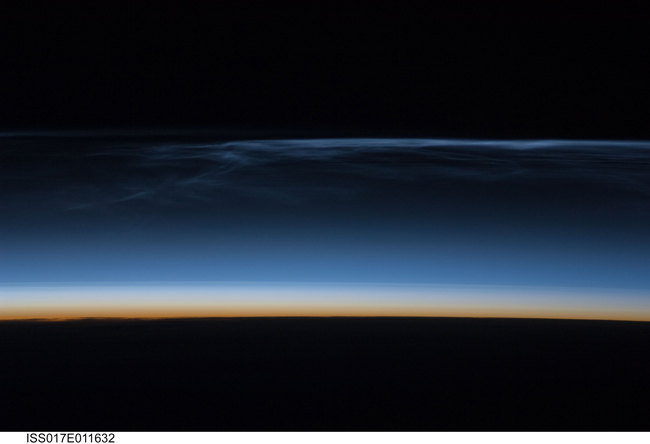Strange Clouds Spotted at the Edge of Space

A weirdly wonderful sight appeared to astronauts aboard the International Space Station this summer — thin blue clouds hovering at the boundary between Earth's atmosphere and the void.
The noctilucent or "night-shining" clouds are at an altitude of 47 to 53 miles (76 to 85 km), where meteors and bright aurora lights are not uncommon and the atmosphere gives way to the blackness of space. The clouds remain a scientifically baffling phenomenon more than 120 years after their discovery.
"It's lovely," said Gary Thomas, an atmospheric scientist at the University of Colorado after looking at a photo taken from the space station. "And it shows just how high these clouds really are ? at the very edge of space."
The clouds form at dizzying heights where the air is one hundred million times drier than the Sahara. By contrast, the common high-altitude cirrus clouds only reach heights of 11 miles (18 km) up.
"We have a fairly good idea that the water vapor from below gets transported upwards," Thomas told SPACE.com."That is in essence the fuel."
Part of that water vapor comes from rising air in the tropics, where a few parts per million of water escape into the farthest reaches of the upper atmosphere. Another likely source of water vapor is methane oxidation. Methane concentrations have more than doubled over the past 100years, which could explain part of the changes in the high-flying clouds over the past decades.
People first spotted the noctilucent clouds a few years after the 1883 eruption of the Krakatoa super-volcano in Indonesia creating spectacular sunsets from ash in the atmosphere. Robert Leslie of Southampton, England saw the clouds one evening in July 1885 and published the first observations in the journal Nature.
Breaking space news, the latest updates on rocket launches, skywatching events and more!
The clouds have since spread from the northern latitude regions such as Scandinavia, Scotland and Siberia to areas farther south. Sightings have cropped up in Washington and Oregon in the United States, as well as in Turkey and Iran.
Scientists can observe widespread instances of this cloudsthroughout the polar summer. Some clouds even formed after the fateful launch of the doomed space shuttle Columbia, when 400tons of water from the shuttle exhaust drifted toward the South Pole.
The mystery only thickened after the launch of a satellite dubbed Aeronomy of Ice in the Mesosphere (AIM) in 2007, when AIM spotted a type of "stealth" noctilucent cloud made of smaller ice crystals less than 30 nanometers (a red blood cell is about 10,000 nanometers). Such clouds appear to stay in the upper atmosphere all the time.
"They're just so tiny that they don't scatter light efficiently," Thomas said.
AIM has also found a strong resemblance between noctilucent clouds and tropospheric clouds that hover near Earth's surface, which suggests that the dynamics of near-space weather may not be incredibly strange after all.
Researchers speculate that the origin and spread of the clouds are linked to patterns of climate change associated with the modern era. But they are not ruling out a host of other possible factors, including methane, carbon dioxide, the number of meteors seeding the upper atmosphere, and even the 11-year sunspot cycle.
"I think the jury's still out on that," Thomas said."We're just trying to understand now how clouds form and how they vary."
- NASA Readies Satellite to Scan Earth's Highest Clouds
- Space Station Crew Photographs Mysterious Clouds that Shine at Night
- IMAGES - Sky Scenes
Join our Space Forums to keep talking space on the latest missions, night sky and more! And if you have a news tip, correction or comment, let us know at: community@space.com.
Jeremy Hsu is science writer based in New York City whose work has appeared in Scientific American, Discovery Magazine, Backchannel, Wired.com and IEEE Spectrum, among others. He joined the Space.com and Live Science teams in 2010 as a Senior Writer and is currently the Editor-in-Chief of Indicate Media. Jeremy studied history and sociology of science at the University of Pennsylvania, and earned a master's degree in journalism from the NYU Science, Health and Environmental Reporting Program. You can find Jeremy's latest project on Twitter.
